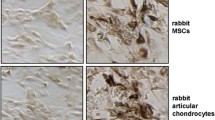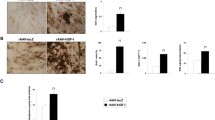Abstract
Chondrogenic growth factors are promising therapeutic agents for articular cartilage repair. A persistent impediment to fulfilling this promise is a limited ability to apply and retain the growth factors within the region of cartilage damage that is in need of repair. Current therapies successfully deliver cells and/or matrices, but growth factors are subject to diffusion into the joint space and then loss from the joint. To address this problem, we created a novel gene that encodes a bifunctional fusion protein comprised by a matrix binding domain and a growth factor. The gene encodes the hyaluronic acid binding region of the cartilage matrix molecule, versican, and the chondrogenic growth factor, insulin-like growth factor-1 (IGF-1). We delivered the gene in an adeno-associated virus-based plasmid vector to articular chondrocytes. The cells synthesized and secreted the fusion protein gene product. The fusion protein bound to hyaluronic acid and retained the anabolic and mitogenic actions of IGF-1 on the chondrocytes. This proof-of-concept study suggests that the bifunctional fusion protein, in concert with chondrocytes and a hyaluronic acid-based delivery vehicle, may serve as an intra-articular therapy to help achieve articular cartilage repair.





Similar content being viewed by others
Abbreviations
- AAV:
-
Adeno-associated virus
- AG1:
-
Aggrecan G1 domain
- AU:
-
Arbitrary unit
- CM:
-
Conditioned medium
- DMB:
-
Dimethylmethlyene blue
- DMEM:
-
Dulbecco’s minimum essential medium
- EDTA:
-
Ethylenediaminetetraacetic acid
- F:
-
Forward primer
- FBS:
-
Fetal bovine serum
- G1:
-
Globular domain 1
- GAG:
-
Glycosaminoglycan
- HA:
-
Hyaluronic acid
- HB-EGF:
-
Heparin-binding epidermal-like growth factor
- HEK-293:
-
Human embryonic kidney 293 cells
- HRP:
-
Horseradish peroxidase
- IGF-1:
-
Insulin-like growth factor-1
- Ka :
-
Equilibrium association constant
- PBS:
-
Phosphate buffered saline
- R:
-
Reverse primer
- SDS:
-
Sodium dodecyl sulfate/sulphate
- TBST:
-
Tris-buffered saline/Tween
- VG1:
-
Versican G1 domain
References
Buckwalter JA, Mankin HJ (1998) Articular cartilage repair and transplantation. Arthritis Rheum 41:1331–1342
Centers for Disease Control and Prevention (2010) Prevalence of doctor-diagnosed arthritis and arthritis-attributable activity limitation–-United States, 2007–2009. MMWR – Morbid Mortal Week Report 59:1261–1265
Trippel SB (1995) Growth factor actions on articular cartilage. J Rheumatol Suppl 43:129–132
Luyten FP, Hascall VC, Nissley SP, Morales TI, Reddi AH (1988) Insulin-like growth factors maintain steady-state metabolism of proteoglycans in bovine articular cartilage explants. Arch Biochem Biophys 267:416–425
McQuillan DJ, Handley CJ, Campbell MA, Bolis S, Milway VE, Herington AC (1986) Stimulation of proteoglycan biosynthesis by serum and insulin-like growth factor-I in cultured bovine articular cartilage. Biochem J 240:423–430
Trippel SB, Corvol MT, Dumontier MF, Rappaport R, Hung HH, Mankin HJ (1989) Effect of somatomedin-C/insulin-like growth factor I and growth hormone on cultured growth plate and articular chondrocytes. Pediatr Res 25:76–82
Madry H, Zurakowski D, Trippel SB (2001) Overexpression of human insulin-like growth factor-I promotes new tissue formation in an ex vivo model of articular chondrocyte transplantation. Gene Ther 8:1443–1449
Nixon AJ, Fortier LA, Williams J, Mohammed H (1999) Enhanced repair of extensive articular defects by insulin-like growth factor-I-laden fibrin composites. J Orthop Res 17:475–487. https://doi.org/10.1002/jor.1100170404
Guerne PA, Sublet A, Lotz M (1994) Growth factor responsiveness of human articular chondrocytes: distinct profiles in primary chondrocytes, subcultured chondrocytes, and fibroblasts. J Cell Physiol 158:476–484
Sah RL, Chen AC, Grodzinsky AJ, Trippel SB (1994) Differential effects of bFGF and IGF-I on matrix metabolism in calf and adult bovine cartilage explants. Arch Biochem Biophys 308:137–147
Tyler JA (1989) Insulin-like growth factor 1 can decrease degradation and promote synthesis of proteoglycan in cartilage exposed to cytokines. Biochem J 260:543–548
Mankin HJ MV, Buckwalter JA, Iannotti JP, Ratcliffe A (2000) Orthopaedic basic science ed 2. AAOS, pp. 444–470.
Matsumoto K, Shionyu M, Go M, Shimizu K, Shinomura T, Kimata K, Watanabe H (2003) Distinct interaction of versican/PG-M with hyaluronan and link protein. J Biol Chem 278:41205–41212
Shi S, Grothe S, Zhang Y, O’Connor-McCourt MD, Poole AR, Roughley PJ, Mort JS (2004) Link protein has greater affinity for versican than aggrecan. J Biol Chem 279:12060–12066
Wang QG, Hughes N, Cartmell SH, Kuiper NJ (2010) The composition of hydrogels for cartilage tissue engineering can influence glycosaminoglycan profile. Eur Cell Mater 19:86–95. https://doi.org/10.22203/ecm.v019a09
Abatangelo G, Vindigni V, Avruscio G, Pandis L, Brun P (2020) Hyaluronic acid: redefining its role. Cells. https://doi.org/10.3390/cells9071743
Prestwich GD (2007) Simplifying the extracellular matrix for 3-D cell culture and tissue engineering: a pragmatic approach. J Cell Biochem 101:1370–1383
Park H, Choi B, Hu J, Lee M (2013) Injectable chitosan hyaluronic acid hydrogels for cartilage tissue engineering. Acta Biomater 9:4779–4786. https://doi.org/10.1016/j.actbio.2012.08.033
Sheu SY, Chen WS, Sun JS, Lin FH, Wu T (2013) Biological characterization of oxidized hyaluronic acid/resveratrol hydrogel for cartilage tissue engineering. J Biomed Mater Res A 101:3457–3466. https://doi.org/10.1002/jbm.a.34653
Bian L, Zhai DY, Tous E, Rai R, Mauck RL, Burdick JA (2011) Enhanced MSC chondrogenesis following delivery of TGF-β3 from alginate microspheres within hyaluronic acid hydrogels in vitro and in vivo. Biomaterials 32:6425–6434. https://doi.org/10.1016/j.biomaterials.2011.05.033
Marcacci M, Berruto M, Brocchetta D, Delcogliano A, Ghinelli D, Gobbi A, Kon E, Pederzini L, Rosa D, Sacchetti GL, Stefani G, Zanasi S (2005) Articular cartilage engineering with Hyalograft C: 3-year clinical results. Clin Orthop Relat Res. https://doi.org/10.1097/01.blo.0000165737.87628.5b
Brun P, Dickinson SC, Zavan B, Cortivo R, Hollander AP, Abatangelo G (2008) Characteristics of repair tissue in second-look and third-look biopsies from patients treated with engineered cartilage: relationship to symptomatology and time after implantation. Arthritis Res Ther 10:R132. https://doi.org/10.1186/ar2549
Kon E, Filardo G, Berruto M, Benazzo F, Zanon G, Della Villa S, Marcacci M (2011) Articular cartilage treatment in high-level male soccer players: a prospective comparative study of arthroscopic second-generation autologous chondrocyte implantation versus microfracture. Am J Sports Med 39:2549–2557. https://doi.org/10.1177/0363546511420688
Franceschi F, Longo UG, Ruzzini L, Marinozzi A, Maffulli N, Denaro V (2008) Simultaneous arthroscopic implantation of autologous chondrocytes and high tibial osteotomy for tibial chondral defects in the varus knee. Knee 15:309–313. https://doi.org/10.1016/j.knee.2008.04.007
Caldwell J (2000) A Safety Tolerability and Pharmacokinetic Study of Intra-Articular Recombinant Human Insulin-Like Growth Factor (rhIFG-I) in Patients with Severe Osteoarthritis (OA) of the Knee. America College of Rheumatology 64th Annual Scientific Meeting (2000) Abstract 941. Abstract Supplement 2000:S233
Miller RE, Grodzinsky AJ, Cummings K, Plaas AHK, Cole AA, Lee RT, Patwari P (2010) Intraarticular injection of heparin-binding insulin-like growth factor 1 sustains delivery of insulin-like growth factor 1 to cartilage through binding to chondroitin sulfate. Arthritis Rheum 62:3686–3694. https://doi.org/10.1002/art.27709
Lorentz KM, Yang L, Frey P, Hubbell JA (2012) Engineered insulin-like growth factor-1 for improved smooth muscle regeneration. Biomaterials 33:494–503. https://doi.org/10.1016/j.biomaterials.2011.09.088
Van Lonkhuyzen DR, Hollier BG, Shooter GK, Leavesley DI, Upton Z (2007) Chimeric vitronectin: insulin-like growth factor proteins enhance cell growth and migration through co-activation of receptors. Growth Factors 25:295–308. https://doi.org/10.1080/08977190701803752
Aguilar IN, Trippel S, Shi S, Bonassar LJ (2017) Customized biomaterials to augment chondrocyte gene therapy. Acta Biomater 53:260–267. https://doi.org/10.1016/j.actbio.2017.02.008
Fortier LA, Mohammed HO, Lust G, Nixon AJ (2002) Insulin-like growth factor-I enhances cell-based repair of articular cartilage. J Bone Joint Surg Br 84:276–288
Madry H, Kaul G, Cucchiarini M, Stein U, Zurakowski D, Remberger K, Menger MD, Kohn D, Trippel SB (2005) Enhanced repair of articular cartilage defects in vivo by transplanted chondrocytes overexpressing insulin-like growth factor I (IGF-I). Gene Ther 12:1171–1179
Zhang Z, Li L, Yang W, Cao Y, Shi Y, Li X, Zhang Q (2017) The effects of different doses of IGF-1 on cartilage and subchondral bone during the repair of full-thickness articular cartilage defects in rabbits. Osteoarthritis Cartilage 25:309–320. https://doi.org/10.1016/j.joca.2016.09.010
Goodrich LR, Hidaka C, Robbins PD, Evans CH, Nixon AJ (2007) Genetic modification of chondrocytes with insulin-like growth factor-1 enhances cartilage healing in an equine model. J Bone Joint Surg Br 89:672–685
Knutsen G, Drogset JO, Engebretsen L, Grøntvedt T, Ludvigsen TC, Løken S, Solheim E, Strand T, Johansen O (2016) A randomized multicenter trial comparing autologous chondrocyte implantation with microfracture: long-term follow-up at 14 to 15 years. J Bone Joint Surg Am 98:1332–1339. https://doi.org/10.2106/jbjs.15.01208
Niemeyer P, Laute V, John T, Becher C, Diehl P, Kolombe T, Fay J, Siebold R, Niks M, Fickert S, Zinser W (2016) The effect of cell dose on the early magnetic resonance morphological outcomes of autologous cell implantation for articular cartilage defects in the knee: a randomized clinical trial. Am J Sports Med 44:2005–2014. https://doi.org/10.1177/0363546516646092
Marcacci M, Zaffagnini S, Kon E, Visani A, Iacono F, Loreti I (2002) Arthroscopic autologous chondrocyte transplantation: technical note. Knee Surg Sports Traumatol Arthrosc 10:154–159. https://doi.org/10.1007/s00167-001-0275-6
Hevesi M, Krych AJ, Saris DBF (2019) Treatment of cartilage defects with the matrix-induced autologous chondrocyte implantation cookie cutter technique. Arthrosc Tech 8:e591–e596. https://doi.org/10.1016/j.eats.2019.01.022
Richardson JB, Wright KT, Wales J, Kuiper JH, McCarthy HS, Gallacher P, Harrison PE, Roberts S (2017) Efficacy and safety of autologous cell therapies for knee cartilage defects (autologous stem cells, chondrocytes or the two): randomized controlled trial design. Regen Med 12:493–501. https://doi.org/10.2217/rme-2017-0032
Park YB, Ha CW, Lee CH, Yoon YC, Park YG (2017) Cartilage regeneration in osteoarthritic patients by a composite of allogeneic umbilical cord blood-derived mesenchymal stem cells and hyaluronate hydrogel: results from a clinical trial for safety and proof-of-concept with 7 years of extended follow-up. Stem Cells Transl Med 6:613–621. https://doi.org/10.5966/sctm.2016-0157
Shi S, Mercer S, Eckert GJ, Trippel SB (2012) Regulation of articular chondrocyte aggrecan and collagen gene expression by multiple growth factor gene transfer. J Orthop Res 30:1026–1031. https://doi.org/10.1002/jor.22036
Funding
This research was funded in part by the National Institute of Arthritis and Musculoskeletal and Skin Diseases, Grant/Award Number: AR047702; U.S. Department of Veterans Affairs, Grant/Award Number: I01 BX000447; Indiana University School of Medicine Research Infrastructure Fund; and Indiana University Department of Orthopaedic Surgery. The content is solely the responsibility of the authors and does not necessarily represent the official views of the National Institutes of Health.
Author information
Authors and Affiliations
Contributions
Conceptualizaton: SS and ST. Methodology: SS, ST, and CW. Validation: SS, CW and ST. Formal analysis: SS and ST. Investigation: SS and CW. Resources: ST. Writing – original draft: SS and ST. Writing-review & editing: SS, ST, and CW. Visualization: SS. Project administration: SS and ST. Funding acquisition: ST.
Corresponding author
Ethics declarations
Conflict of interest
The authors declare no conflicts of interest. The funders had no role in the design of the study, in the collection, analysis, or interpretation of data, in the writing of the manuscript, or in the decision to publish the results.
Additional information
Publisher's Note
Springer Nature remains neutral with regard to jurisdictional claims in published maps and institutional affiliations.
Electronic supplementary material
Below is the link to the electronic supplementary material.
Rights and permissions
About this article
Cite this article
Shi, S., Wang, C. & Trippel, S.B. Hyaluronic acid-binding insulin-like growth factor-1: Creation of a gene encoding a bifunctional fusion protein. Mol Biol Rep 47, 9749–9756 (2020). https://doi.org/10.1007/s11033-020-06034-w
Received:
Accepted:
Published:
Issue Date:
DOI: https://doi.org/10.1007/s11033-020-06034-w




